Streamlining Construction Purchasing Workflows: Drenchworks Case Study
Overview
For two and a half months, I worked as the UX/UI Designer with Drenchworks, an early-stage US-based startup, through Eleken, a SaaS design agency, building a modern platform for plumbing and mechanical contractors. I was tasked with designing a comprehensive Purchasing section that would address critical industry challenges while integrating seamlessly with their existing product.
Understanding the Industry Challenge
Working in plumbing and mechanical contracting presents unique inventory and purchasing challenges that directly impact business efficiency:
- Emergency repairs require immediate inventory access: Technicians must carry essential supplies (pipes, fittings, caps, ball valves) to job sites to fix issues quickly without wasting time searching for or purchasing materials
- Planned projects need advanced procurement: These jobs require careful scheduling of purchases, accounting for supplier delivery times and international imports for specialized materials
- Scale creates complexity: Even relatively small projects can require hundreds of different materials, demanding constant supplier interaction regarding pricing, payment, and shipping
Drenchworks' customers needed a solution that could handle this complexity while remaining intuitive. Previous designers had created basic UI mockups but lacked the UX expertise to design workflows that reflected how construction professionals actually work.
My Approach: Research-Driven Problem Solving
I conducted a thorough research process to understand the construction accounting domain:
- Competitive analysis of similar construction management platforms to identify common patterns and best practices
- Stakeholder interviews to gather specific requirements and understand existing customer feedback
- Industry standards review to ensure compliance with construction accounting practices
To supplement these standard methods, I also employed a creative research approach by analyzing YouTube tutorials and videos created by construction industry experts. This provided additional insights into how accountants and project managers handle purchasing processes in real-world scenarios.
This multi-faceted research gave me a comprehensive understanding of industry terminology, workflow expectations, and common user pain points. My designs were based on both stakeholder requirements and observed behaviors of professionals in the field.

Designing Solutions for Real-World Problems
Creating Functional Purchase Order Management
A purchase order in this context represents a list of items to be purchased from a specific vendor for a particular project (e.g., "PVC Pipe"). I designed the system to:
- Clearly organize purchase orders by vendor and project
- Visualize order status ("Draft," "Scheduled," "Sent to vendor") using color-coded tags
- Enable quick status transitions through a logical workflow
- Support the creation of purchasing lists that could be converted to formal purchase orders

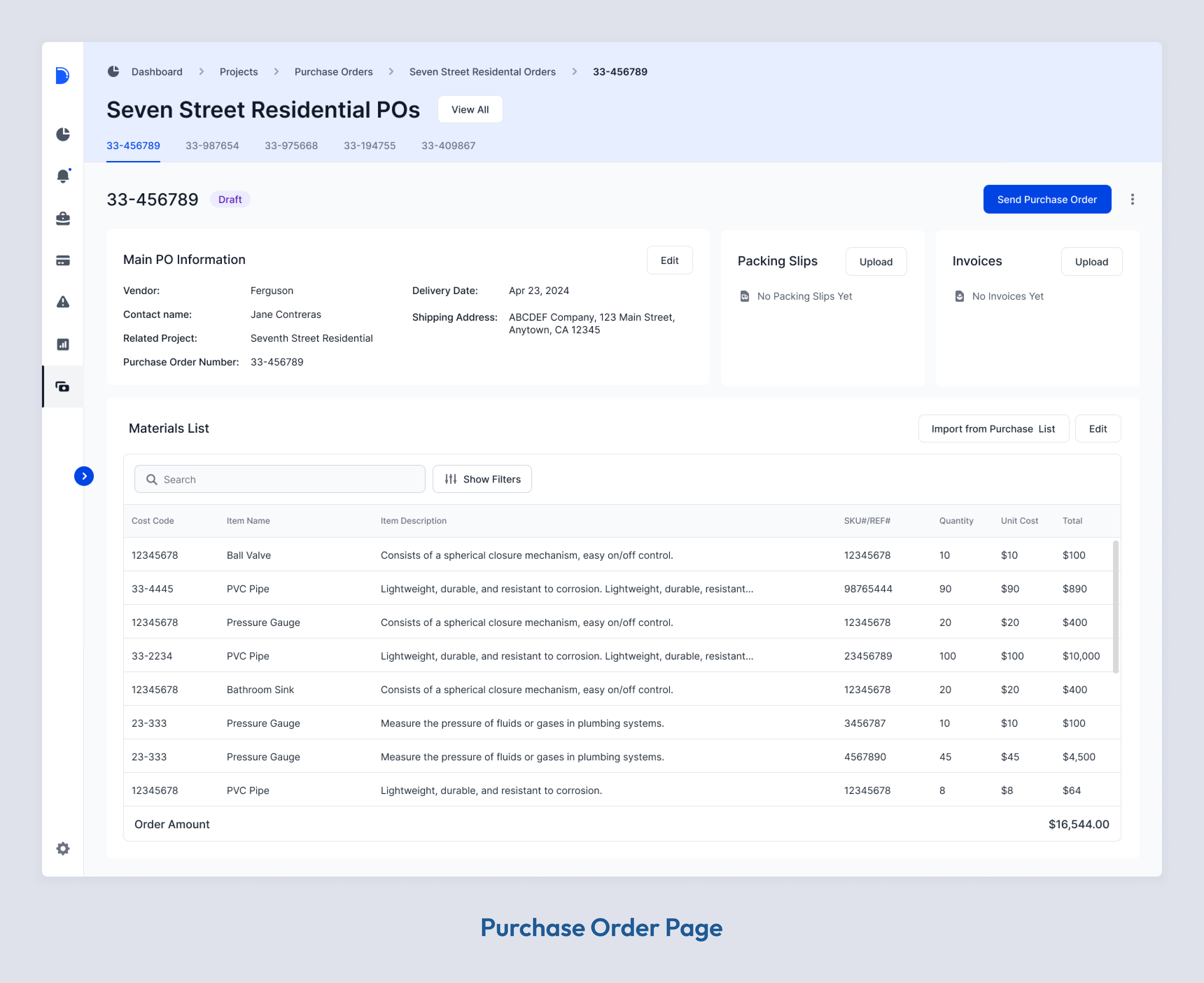
Enhancing Table Functionality
Since tables formed the backbone of the system, efficient data handling was crucial. I designed tables with robust functionality:
- Sorting and complex filtering to have a flexible view of data
- Bulk actions to increase efficiency of the workflow
- Ability to copy-paste the whole table or a particular group of cells, to enable smooth work with external tables
- Grouping of rows to increase visual scannability of data
- Uploading CSV to fill in the table and downloading the table as CSV
New tables drastically increased the functionality of Drenchworks, while maintaining visual consistency.
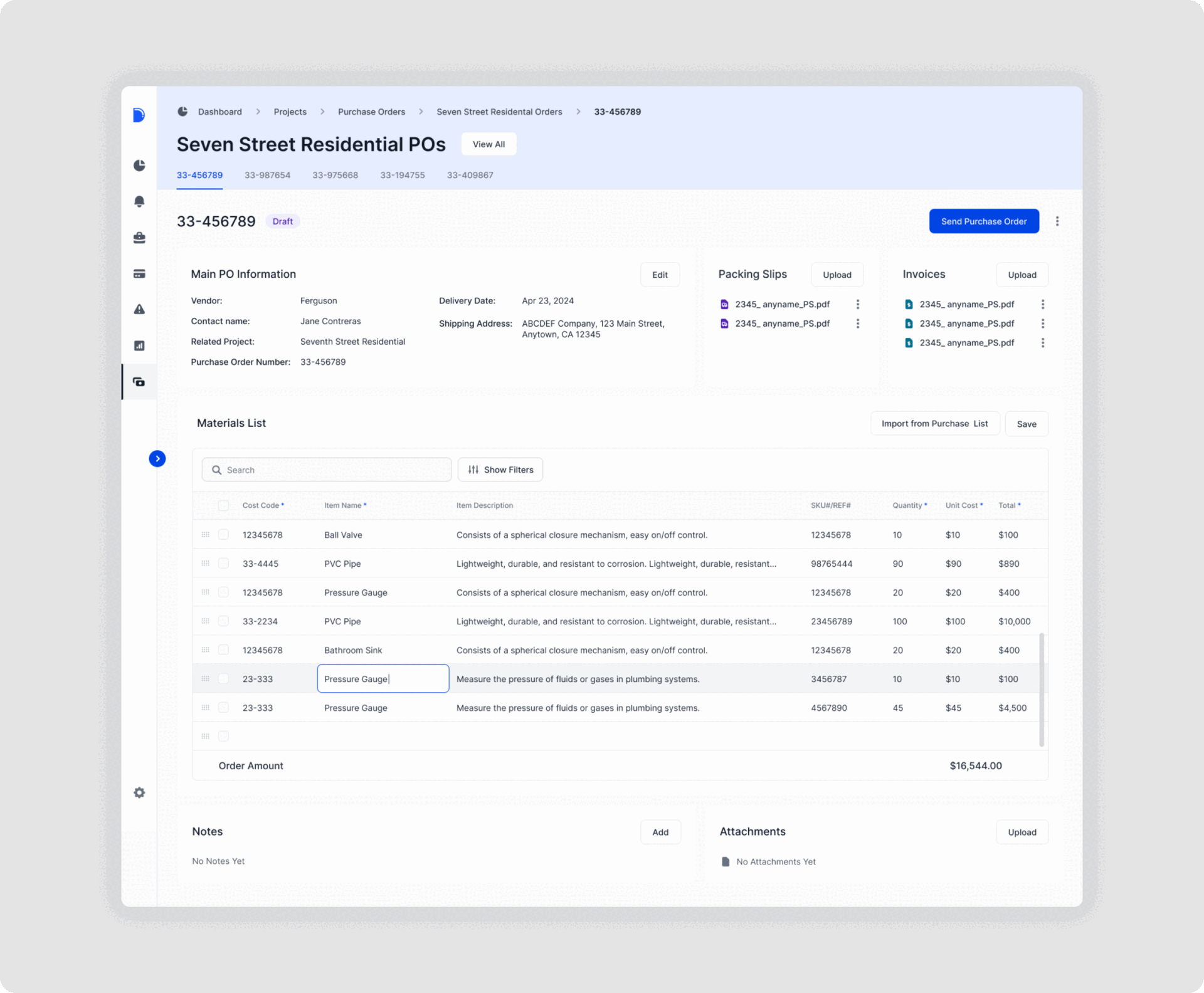
Simplifying Complex Navigation
The original navigation structure created unnecessary cognitive load. I redesigned it by:
- Removing redundant subtitles that caused visual noise
- Implementing a tab-based structure instead of confusing three-level navigation
- Creating a collapsible sidebar to maximize space for content
- Adding breadcrumbs to help users track their location
These changes directly addressed user frustration with navigation complexity, making it easier to move between different sections of the purchasing workflow and saving space for tables.
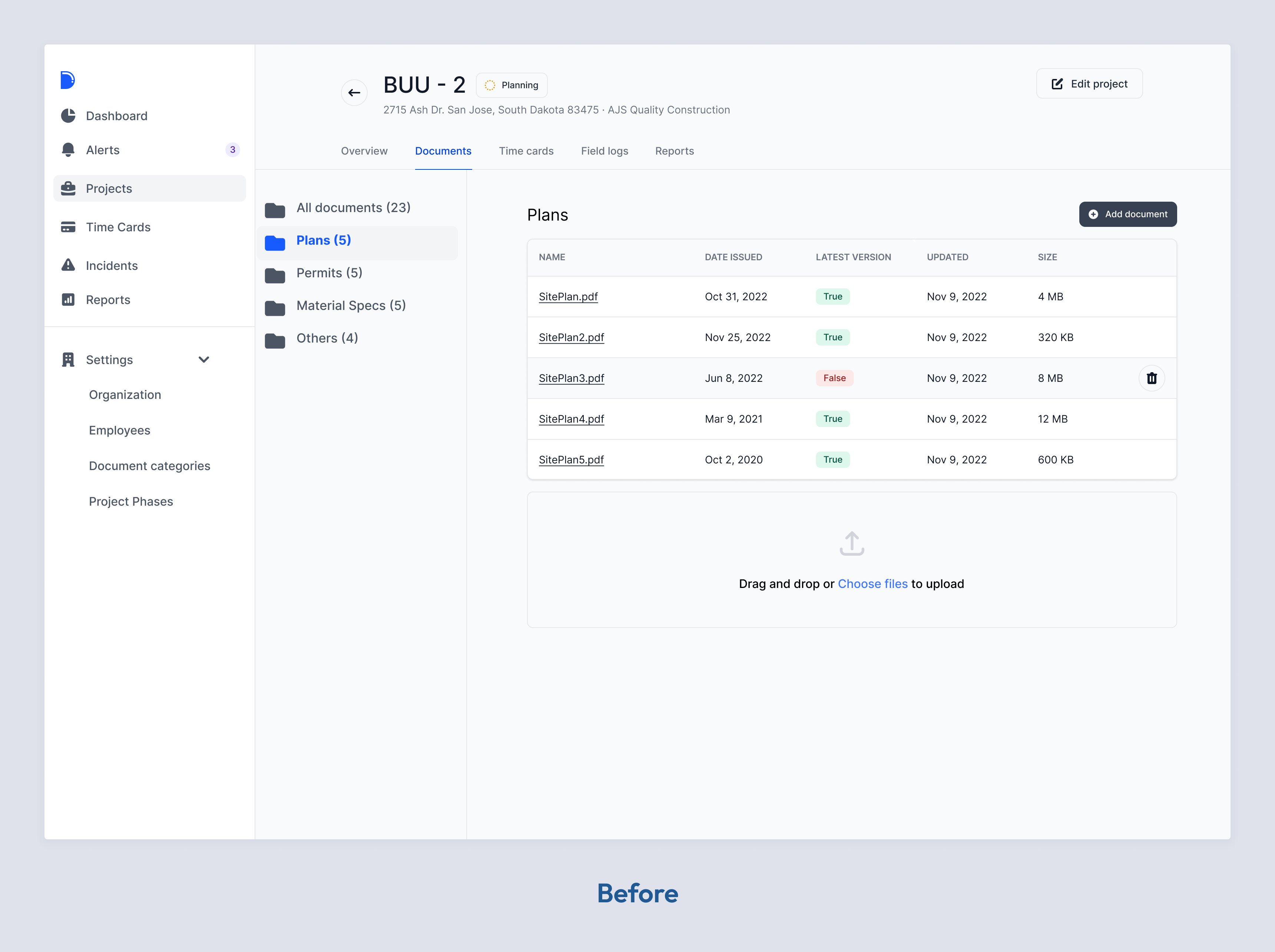

Designing for Document Workflows
I carefully mapped how purchase documents would flow through the system:
- Created clear paths for creating purchase lists and converting them to orders
- Designed interfaces for reviewing, approving, and tracking orders
- Implemented status transitions that reflected actual business processes
This approach ensured that the digital workflow matched the real-world purchasing process, reducing friction and training requirements.
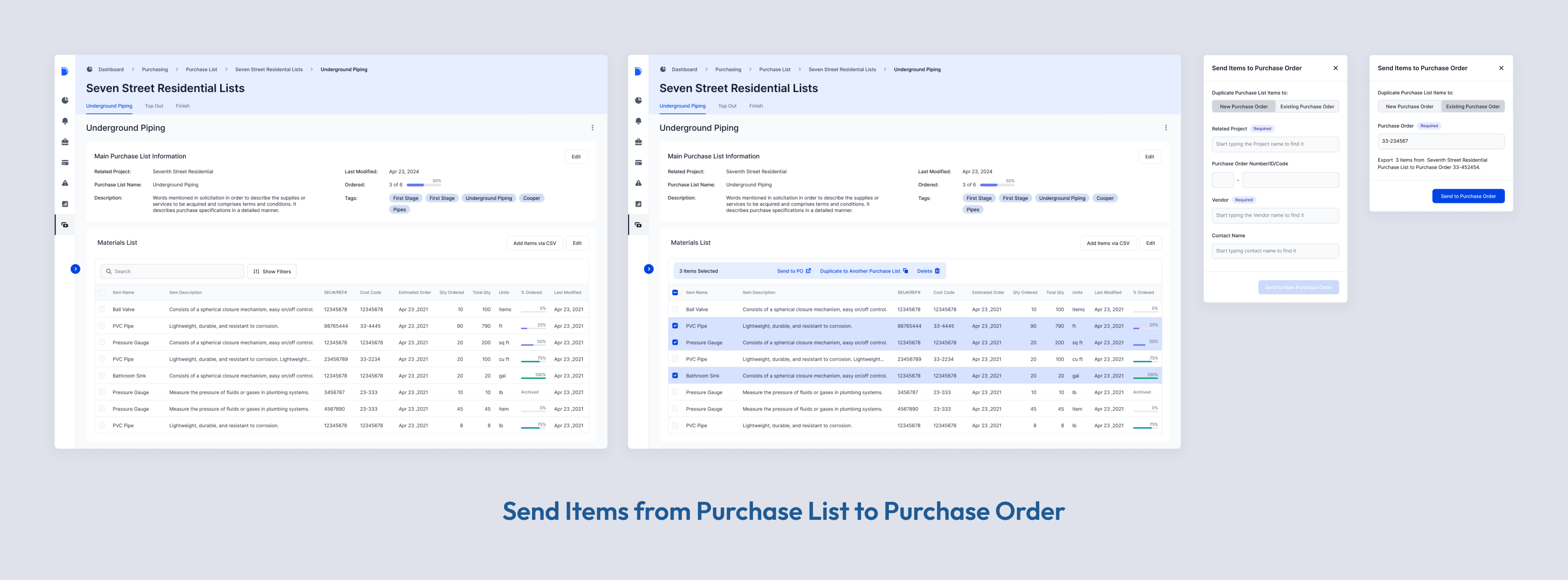
Collaborative Development and Iteration
My work involved continuous communication with Drenchworks' CEO and CTO. Our process typically followed this pattern:
- Research & Discovery: Understanding specific purchasing workflows
- Design & Discussion: Creating solutions and gathering stakeholder feedback
- User Validation: Testing with existing customers to verify that designs met real needs
- Refinement: Adjusting designs based on feedback, often reorganizing elements to better match user expectations
- Documentation & Design Handover: Creating detailed Figma prototypes and Notion documentation to ensure correct implementation by the development team
This collaborative approach ensured that designs were aligned with both business goals and the practical needs of construction professionals.

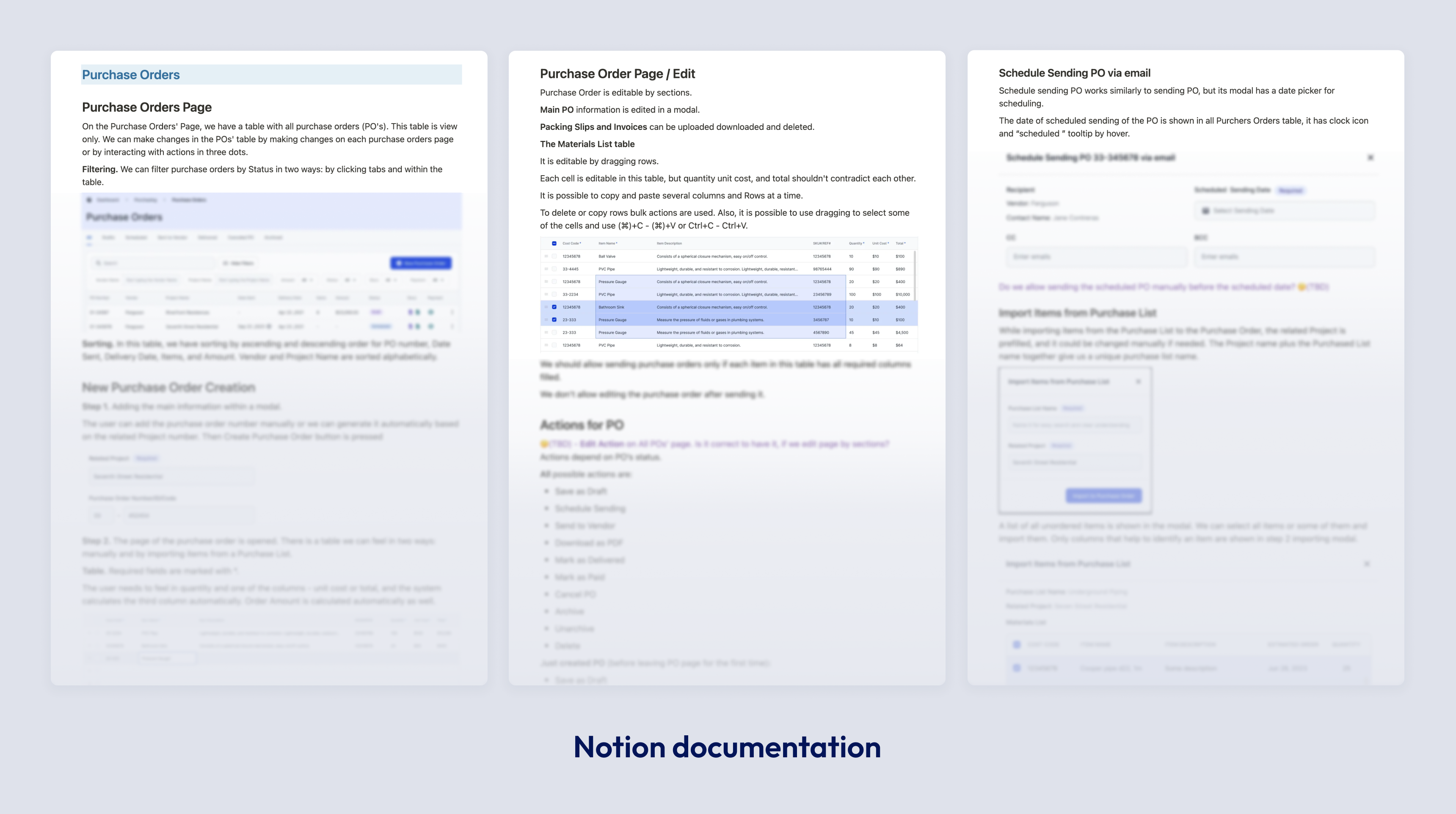
Expanding Beyond the Core Product
As our engagement progressed, I also:
- Designed the initial version of Drenchworks' landing page
- Created marketing materials to communicate their value proposition
These additional deliverables helped Drenchworks present a cohesive brand experience while highlighting the value of their comprehensive solution for construction management challenges.
Results and Impact
The completed design work delivered tangible benefits for both Drenchworks and its users:
- Comprehensive Purchasing module that reflected actual construction workflows
- Intuitive navigation system reducing cognitive load for busy contractors
- Advanced table functionality that supported complex data management needs
- Cohesive brand experience from marketing to product use
These deliverables enabled Drenchworks to implement powerful purchasing capabilities without sacrificing usability. The table design in particular represented a significant advancement, allowing construction professionals to manipulate complex datasets in ways that matched their existing mental models while maintaining visual consistency with the rest of the application.
Feedback from early adopters indicated that the streamlined navigation and powerful table functionality were particularly valuable for managing complex projects with hundreds of materials and multiple suppliers.
Reflection
This project highlighted the importance of understanding specialized workflows when designing for industry-specific software. By combining traditional research methods with creative approaches and working closely with stakeholders, I created interfaces that aligned with the actual needs of construction professionals.
The process also demonstrated the value of thorough research and iterative design, especially when working in domains with complex requirements and specialized user needs. By combining industry knowledge with thoughtful UX principles, I delivered a solution that added substantial value to Drenchworks' platform.
